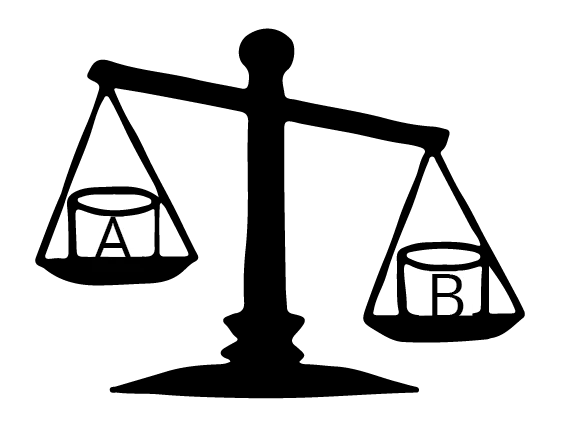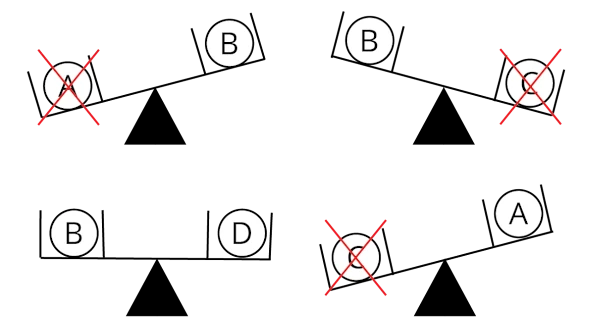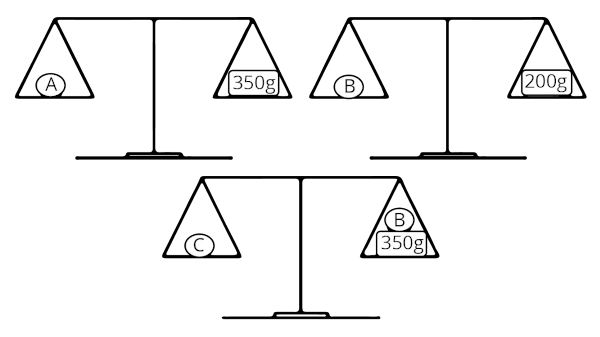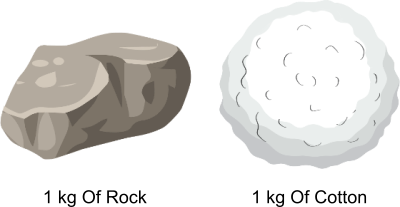Mass
In this article, we will look at the following:
- Comparison of mass given balance scales
- Conversion of mass
- Comparison of mass
1. Comparison Of Mass Given Balance Scales

From the diagram, we know that:
- Container A is lighter than Container B.
- Container B is heavier than Container A.
Question 1:
Which container is the lightest?

Solution:
To find the lightest container, we cross out all the heavier containers on each scale.

We cross out Container B on the first balance, Container A on the second balance and Container D on the third balance.
We are then left with Container A on the first balance, and Container C on the second and third balance.
Since Container A was crossed out, we know that Container C is the lightest.
Answer:
Container C is the lightest.
Question 2:
Arrange the objects in order, beginning with the lightest.

Solution:

To find the lightest object, we cross out the heavier objects on the 2 balances.
We cross out Object A on the first balance and Object B on the second balance.
Hence, C is the lightest.
To find the heaviest object, we cross out the lighter objects on the 2 balances.
We cross out Object B on the first balance and Object C on the second balance.
Hence, Object A is the heaviest.
Answer:
|
C |
, |
B |
, |
A |
|
Lightest |
|
|
|
Heaviest |
Question 3:
Which object is the heaviest?

Solution:

To find the heaviest object, we cross out the lighter objects on the balances.
We cross out Object B on the first and the second balances and Object A on the last balance.
As shown on the third balance, Object B and Object D have the same mass.
Hence, Object C is the heaviest.
Answer:
Container C is the heaviest.
Question 4:
Which object is the heaviest?

Solution:
Mass of Object A \(= 350 \text{ g}\)
Mass of Object B \(= 200 \text{ g}\)
Mass of Object C \(=\) Mass of Object B \(+ \;350 \text{ g}\)
\( = 200 \text{ g} + 350 \text{ g}\)
\(= 550 \text{ g}\)
Answer:
Container C is the heaviest.
2. Conversion Of Mass
To express mass in kilograms to grams and vice versa, we need to remember that:
\(1 \text{ kg} = 1000 \text{ g}\)
Question 1:
Express the following in grams.
\(2 \text{ kg } =\) __________ \(\text{ g}\)
Solution:
\(2 \text{ kg} = 2000 \text{ g}\)
Answer:
\(2000 \text{ g}\)
Question 2:
Express the following in grams.
\(3 \text{ kg } 500 \text{ g} =\)__________ \(\text{ g}\)
Solution:
\(\begin{align} 3 \text{ kg } 500 \text{ g} &= 3000 \text{ g} + 500 \text{ g}\\ &= 3500 \text{ g} \end{align}\)
Answer:
\(3500 \text{ g}\)
Question 3:
Express the following in grams.
\(5 \text{ kg } 27 \text{ g} =\)__________ \(\text{ g}\)
Solution:
\(\begin{align} 5 \text{ kg } 27 \text{ g} &= 5000 \text{ g} + 27 \text{ g}\\ &= 5027 \text{ g} \end{align}\)
Answer:
\(5027 \text{ g}\)
Question 4:
Express the following in grams.
\(3 \text{ kg } 52 \text{ g} =\)__________ \(\text{ g}\)
Solution:
\(\begin{align} 3 \text{ kg } 52 \text{ g} &= 3000 \text{ g} + 52 \text{ g}\\ &= 3052 \text{ g} \end{align}\)
Answer:
\(3052 \text{ g}\)
Question 5:
Express the following in grams.
\(1 \text{ kg } 300 \text{ g} =\)__________ \(\text{ g}\)
Solution:
\(\begin{align} 1 \text{ kg } 300 \text{ g} &= 1000 \text{ g} + 300 \text{ g}\\ &= 1300 \text{ g} \end{align}\)
Answer:
\(1300 \text{ g}\)
Question 6:
Express the following in grams.
\(7 \text{ kg } 6 \text{ g} =\)__________ \(\text{ g}\)
Solution:
\(\begin{align} 7 \text{ kg } 6 \text{ g} &= 7000 \text{ g} + 6 \text{ g} \\ &= 7006 \text{ g} \end{align}\)
Answer:
\(7006 \text{ g}\)
Question 7:
Express the following in grams.
\(6 \text{ kg } 20 \text{ g} =\)__________ \(\text{ g}\)
Solution:
\(\begin{align} 6 \text{ kg } 20 \text{ g} &= 6000 \text{ g} + 20 \text{ g}\\ &= 6020 \text{ g} \end{align}\)
Answer:
\(6020 \text{ g}\)
Question 8:
Express the following in kilograms and grams.
\(3000 \text{ g} =\) __________ \(\text{ kg} \)
Solution:
\(3000 \text{ g} = 3 \text{ kg} \)
Answer:
\(3 \text{ kg}\)
Question 9:
Express the following in kilograms and grams.
\(4800 \text{ g} =\)__________ \(\text{ kg}\) __________ \(\text{ g}\)
Solution:
\(\begin{align} 4800 \text{ g} &= 4000 \text{ g} + 800 \text{ g} \\ &= 4 \text{ kg } 800 \text{ g} \end{align}\)
Answer:
\(4 \text{ kg } 800 \text{ g}\)
Question 10:
Express the following in kilograms and grams.
\(2500 \text{ g} =\)__________ \(\text{ kg}\) __________ \(\text{ g}\)
Solution:
\(\begin{align} 2500 \text{ g} &= 2000 \text{ g} + 500 \text{ g}\\ &= 2 \text{ kg } 500 \text{ g} \end{align}\)
Answer:
\(2 \text{ kg } 500 \text{ g}\)
Question 11:
Express the following in kilograms and grams.
\(3070 \text{ g} =\)__________ \(\text{ kg}\) __________ \(\text{ g}\)
Solution:
\(\begin{align} 3070 \text{ g} &= 3000 \text{ g} + 70 \text{ g}\\ &= 3 \text{ kg } 70 \text{ g} \end{align}\)
Answer:
\(3 \text{ kg } 70 \text{ g}\)
Question 12:
Express the following in kilograms and grams.
\(5900 \text{ g} =\)__________ \(\text{ kg}\) __________ \(\text{ g}\)
Solution:
\(\begin{align} 5900 \text{ g} &= 5000 \text{ g} + 900 \text{ g}\\ &= 5 \text{ kg } 900 \text{ g} \end{align}\)
Answer:
\(5 \text{ kg } 900 \text{ g}\)
Question 13:
Express the following in kilograms and grams.
\(4085 \text{ g} =\)__________ \(\text{ kg}\) __________ \(\text{ g}\)
Solution:
\(\begin{align} 4085 \text{ g} &= 4000 \text{ g} + 85 \text{ g}\\ &= 4 \text{ kg } 85 \text{ g} \end{align}\)
Answer:
\(4 \text{ kg } 85 \text{ g}\)
Question 14:
Express the following in kilograms and grams.
\(7707 \text{ g } =\)__________ \(\text{ kg}\) __________ \(\text{ g}\)
Solution:
\(\begin{align} 7707 \text{ g} &= 7000 \text{ g} + 707 \text{ g}\\ &= 7 \text{ kg } 707 \text{ g} \end{align}\)
Answer:
\(7 \text{ kg } 707 \text{ g}\)
3. Comparison Of Mass
When comparing masses, we express them in the same units first ie: grams before comparing.
Question 1:
Study the pictures carefully:

Which is heavier?
Solution:
The mass of the rock is \(1 \text{ kg}\). The mass of the cotton is \(1 \text{ kg}\).
Hence, both objects have the same mass.
Question 2:
Which of the following is the lightest?
- \(1 \text{ kg } 100 \text{ g}\)
- \(1 \text{ kg } 10 \text{ g}\)
- \(1 \text{ kg } 1 \text{ g}\)
- \(10 \,000 \text{ g} \)
Solution:
Express in grams before comparing.
\(\begin{align} 1 \text{ kg } 100 \text{ g} &= 1000 \text{ g} + 100 \text{ g}\\ &= 1100 \text{ g}\\[2ex] 1 \text{ kg } 10 \text{ g} &= 1000 \text{ g} + 10 \text{ g}\\ &= 1010 \text{ g}\\[2ex] 1 \text{ kg } 1 \text{ g} &= 1000 \text{ g} + 1 \text{ g}\\ &= 1001 \text{ g} \end{align}\)
Answer:
(3) \(1 \text{ kg } 1 \text{ g}\)
Question 3:
Which of the following is the heaviest?
- \(4 \text{ kg } 3 \text{ g}\)
- \(4 \text{ kg } 30 \text{ g}\)
- \(4 \text{ kg } 33 \text{ g}\)
- \(4 \text{ kg } 303 \text{ g}\)
Solution:
Express in grams before comparing.
\(\begin{align} 4 \text{ kg } 3 \text{ g} &= 4000 \text{ g} + 3 \text{ g}\\ &= 4003 \text{ g}\\[2ex] 4 \text{ kg } 30 \text{ g} &= 4000 \text{ g} + 30 \text{ g}\\ &= 4030 \text{ g}\\[2ex] 4 \text{ kg } 33 \text{ g} &= 4000 \text{ g} + 33 \text{ g}\\ &= 4033 \text{ g}\\[2ex] 4 \text{ kg } 303 \text{ g} &= 4000 \text{ g} + 303 \text{ g}\\ &= 4303 \text{ g} \end{align}\)
Answer:
(4) \(4 \text{ kg } 303 \text{ g}\)
Question 4:
Which one of the following is the heaviest?
- A sack of potatoes weighs \(4 \text{ kg } 404 \text{ g}\).
- A cat weighs \(4 \text{ kg } 440 \text{ g}\).
- A watermelon weighs \(4 \text{ kg } 444 \text{ g}\).
- A lamp weighs \(4 \text{ kg } 4 \text{ g}\).
Solution:
Express in grams before comparing.
Mass of the sack of potatoes
\(\begin{align}&= 4000 \text{ g} + 404 \text{ g}\\[2ex] &= 4404 \text{ g} \end{align}\)
Mass of the cat
\(\begin{align}&= 4000 \text{ g} + 440 \text{ g}\\[2ex] &= 4440 \text{ g} \end{align}\)
Mass of the watermelon
\(\begin{align}&= 4000 \text{ g} + 444 \text{ g}\\[2ex] &= 4444 \text{ g} \end{align}\)
Mass of the lamp
\(\begin{align} &= 4000 \text{ g} + 4 \text{ g}\\[2ex] &= 4004 \text{ g} \end{align}\)
Answer:
3) The watermelon is the heaviest.
Question 5:
Arrange the following in ascending order.
\(3 \text{ kg},\; 3 \text{ g},\; 3 \text{ kg } 30 \text{ g},\; 300 \text{ g}\)
Solution:
Ascending order means from the smallest to the greatest.
So, we arrange the following from the lightest to the heaviest.
Express in grams before comparing.
\(\begin{align} 3 \text{ kg } &= 3000 \text{ g}\\[2ex] 3 \text{ kg } 30 \text{ g} &= 3000 \text{ g} + 30 \text{ g}\\ &= 3030 \text{ g} \end{align}\)
Arranging them in ascending order:
\(3 \text{ g},\; 300 \text{ g},\; 3 \text{ kg},\; 3 \text{ kg } 30 \text{ g}\)
Answer:
\(3 \text{ g},\; 300 \text{ g},\; 3 \text{ kg},\; 3 \text{ kg } 30 \text{ g}\)
Question 6:
Arrange the following in ascending order.
\(3 \text{ kg } 50 \text{ g},\; 3440 \text{ g},\; 3 \text{ kg } 450 \text{ g},\; 3045 \text{ g}\)
Solution:
\(\begin{align} 3 \text{ kg } 50 \text{ g} &= 3000 \text{ g} + 50 \text{ g}\\ &= 3050 \text{ g}\\[2ex] 3 \text{ kg } 450 \text{ g} &= 3000 \text{ g} + 450 \text{ g}\\ &= 3450 \text{ g} \end{align}\)
Arranging the following in ascending order,
\(3045 \text{ g},\; 3 \text{ kg } 50 \text{ g},\; 3440 \text{ g},\; 3 \text{ kg } 450 \text{ g}\)
Answer:
\(3045 \text{ g},\; 3 \text{ kg } 50 \text{ g},\; 3440 \text{ g},\; 3 \text{ kg } 450 \text{ g}\)
Question 7:
Arrange the following in ascending order.
\(2 \text{ kg } 20 \text{ g},\; 2200 \text{ g},\; 2002 \text{ g},\; 2 \text{ kg } 202 \text{ g}\)
Solution:
\(\begin{align} 2 \text{ kg } 20 \text{ g} &= 2000 \text{ g} + 20 \text{ g}\\ &= 2020 \text{ g}\\[2ex] 2 \text{ kg } 202 \text{ g} &= 2000 \text{ g} + 202 \text{ g}\\ &= 2202 \text{ g} \end{align}\)
Arranging the following in ascending order,
\(2002 \text{ g},\; 2 \text{ kg } 20 \text{ g},\; 2200 \text{ g},\; 2 \text{ kg } 202 \text{ g}\)
Answer:
\(2002 \text{ g},\; 2 \text{ kg } 20 \text{ g},\; 2200 \text{ g},\; 2 \text{ kg } 202 \text{ g}\)
Question 8:
Arrange the following in descending order.
\(770 \text{ g},\; 7770 \text{ g},\; 7 \text{ kg } 707 \text{ g},\; 707 \text{ g}\)
Solution:
Descending order means from the greatest to the smallest.
So, we arrange the following from the heaviest to the lightest.
Express in grams before comparing.
\(\begin{align} 7 \text{ kg } 707 \text{ g} &= 7000 \text{ g} + 707 \text{ g}\\ &= 7707 \text{ g} \end{align}\)
Arranging them in descending order:
\(7770 \text{ g},\; 7 \text{ kg } 707 \text{ g},\; 770 \text{ g},\; 707 \text{ g}\)
Answer:
\(7770 \text{ g},\; 7 \text{ kg } 707 \text{ g},\; 770 \text{ g},\; 707 \text{ g}\)
Question 9:
Arrange the following in descending order.
\(1 \text{ kg } 10 \text{ g},\; 1100 \text{ g},\; 101 \text{ g},\; 1 \text{ kg } 101 \text{ g}\)
Solution:
\(\begin{align} 1 \text{ kg } 10 \text{ g} &= 1000 \text{ g} + 10 \text{ g}\\ &= 1010 \text{ g}\\[2ex] 1 \text{ kg } 101 \text{ g} &= 1000 \text{ g} + 101 \text{ g}\\ &= 1101 \text{ g} \end{align}\)
Arranging the following in descending order,
\(1 \text{ kg } 101 \text{ g},\; 1100 \text{ g},\; 1 \text{ kg } 10 \text{ g},\; 101 \text{ g}\)
Answer:
\(1 \text{ kg } 101 \text{ g},\; 1100 \text{ g},\; 1 \text{ kg } 10 \text{ g},\; 101 \text{ g}\)
Question 10:
Arrange the following in descending order.
\(66 \text{ kg } 606 \text{ g}, \;66 \text{ kg } 660 \text{ g},\; 66 \,006 \text{ g},\; 66 \,666 \text{ g}\)
Solution:
\(\begin{align} 66 \text{ kg } 606 \text{ g} &= 66 \,000 \text{ g} + 606 \text{ g}\\ &= 66 \,606 \text{ g}\\[2ex] 66 \text{ kg } 660 \text{ g} &= 66 \,000 \text{ g} + 660 \text{ g}\\ &= 66 \,660 \text{ g} \end{align}\)
Arranging the following in descending order,
\(66 \,666 \text{ g},\; 66 \text{ kg } 660 \text{ g},\; 66 \text{ kg } 606 \text{ g},\; 66 \,006 \text{ g}\)
Answer:
\(66 \,666 \text{ g},\; 66 \text{ kg } 660 \text{ g},\; 66 \text{ kg } 606 \text{ g},\; 66 \,006 \text{ g}\)
Question 11:
Alan is heavier than Owen but lighter than Ivan.
Kimberly is lighter than Alan but heavier than Owen.
Who is the heaviest?
Solution:
In the first statement: Ivan is the heaviest while Owen is the lightest.
Arranging from the lightest to the heaviest,
Owen, Alan, Ivan
In the second statement: Alan is the heaviest while Owen is the lightest.
Arranging from the lightest to the heaviest,
Owen, Kimberly, Alan
Combining information from both statements:
Arranging from the lightest to the heaviest,
Owen, Kimberly, Alan, Ivan
Answer:
Ivan is the heaviest.


 SG
SG  VN
VN 
















